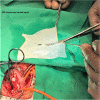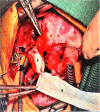Equine pericardium: a versatile alternative reconstructive material in congenital cardiac surgery
- PMID: 33892770
- PMCID: PMC8063344
- DOI: 10.1186/s13019-021-01494-y
Equine pericardium: a versatile alternative reconstructive material in congenital cardiac surgery
Abstract
Background: Pericardial patches are often used for repair of congenital cardiac defects. The aim of this study was to describe our initial experience with the use of equine pericardium and its safety and advantages and disadvantages compared to bovine pericardium.
Methods: We designed a retrospective cohort study of 111 patients who were surgically treated for congenital heart disease between 2017 and 2020. Equine pericardium was used in 58 patients and bovine pericardium was used in 53 patients. Recorded variables included demographic data, preoperative cardiac pathology, site of patch insertion, morbidity and mortality.
Results: The overall survival rate was 94.5% and no deaths were related to patch insertion. None of our patients were reoperated on for patch related complications. Postoperative transcatheter intervention was needed in 2 patients (1.8%): one for dilatation of aortic arch stenosis after repair of hypoplastic left heart syndrome with equine pericardium and one for dilatation of pulmonary artery branches after repair of tetralogy of Fallot using bovine pericardium.
Conclusions: Equine pericardium is a safe patch material for reconstruction in congenital heart surgery. It may be preferable to bovine pericardium in cases requiring a complex shape or a pliable patch as in in arch reconstruction or for valve reconstruction.
Keywords: Cardiac surgery; Congenital heart diseases; Equine pericardium.
Conflict of interest statement
All authors declare that they have no competing interests.
Figures


References
-
- Nataraj C, Ritter G, Dumass S, et al. Extracellular wound matrices: novel stabilization and sterilization method for collagen-based biologic wound dressing. Wounds. 2007;19:148. - PubMed
MeSH terms
Grants and funding
LinkOut - more resources
Full Text Sources
Medical

